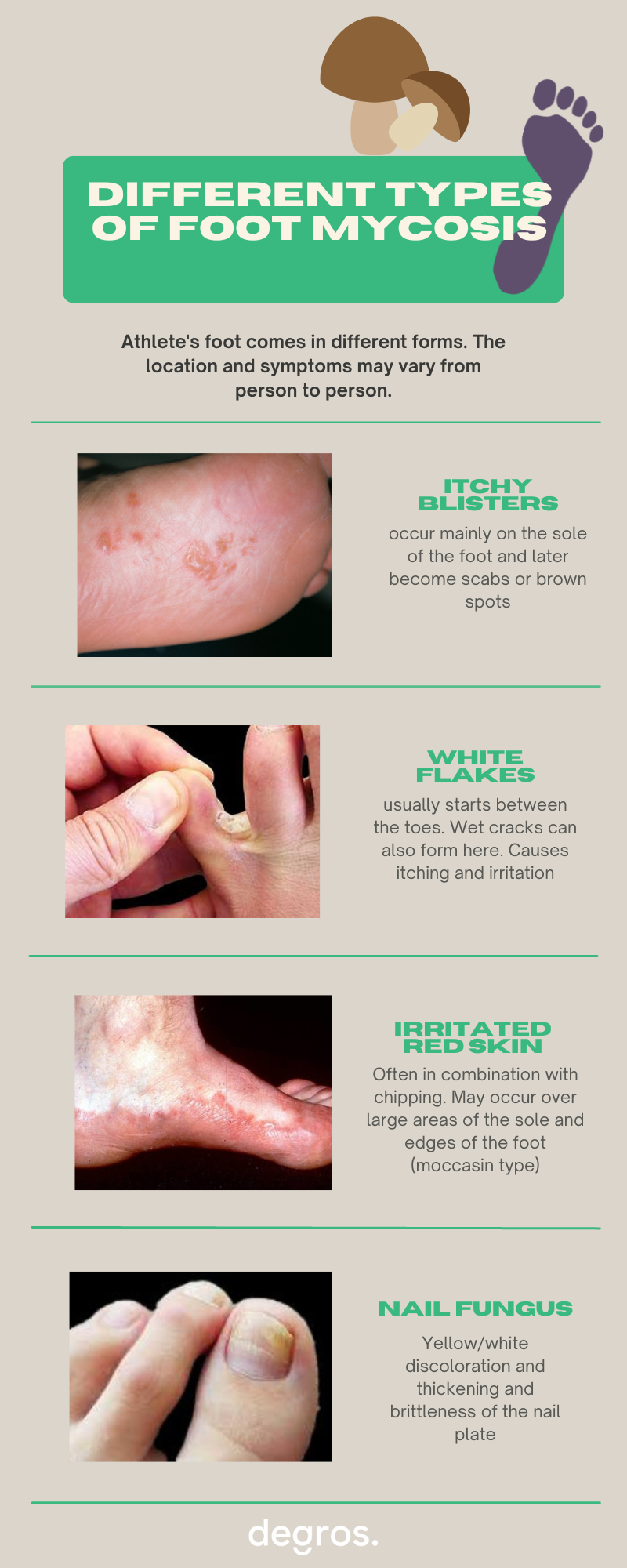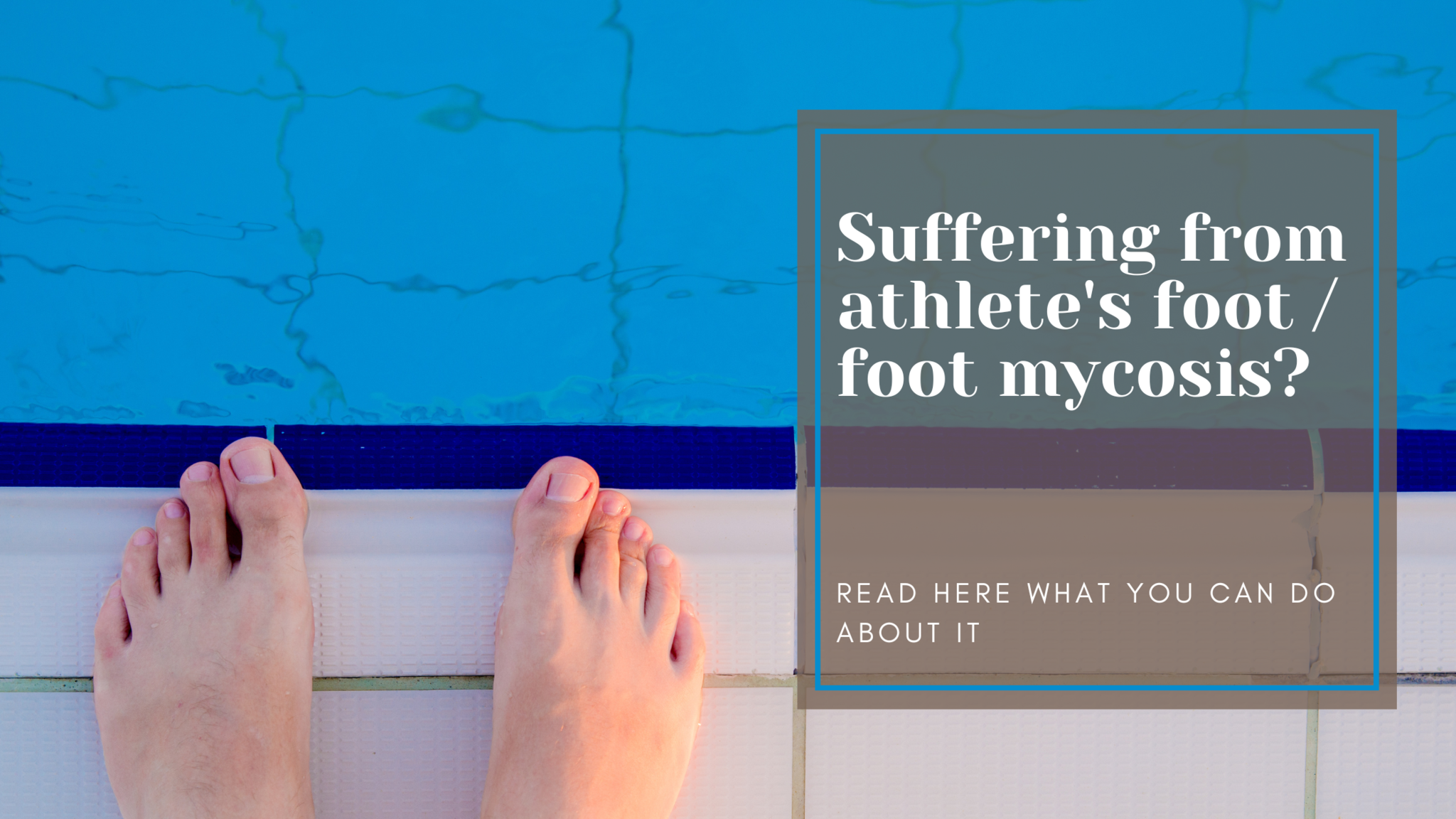What can you do against foot mycosis (athlete's foot)?
Foot mycosis is a common foot problem. In this blog we give you as much information as possible about how it arises and which measures you can best take.
- What is athlete's foot?
- What does athlete's foot look like and what complaints does it cause?
- How do you get athlete's foot?
- Treating athlete's foot
- Tips to prevent athlete's foot/athlete's foot
- Stubborn Athlete's Foot
What is athlete's foot?
Athlete's foot is a collective name for several foot conditions that are caused by a fungal infection. It is also popularly referred to as swimmers foot, because it is a condition that can easily be contracted in swimming pools. The name is Athlete's foot, because of the risk of contamination in shared changing rooms/showers at sports clubs.
It is not eczema, although it often looks very similar. Eczema is an inflammatory reaction of the skin and comes from within. Athlete's foot (athlete's foot) is an external infection. However, it can occur simultaneously. The eczema then arises as a hypersensitivity reaction to the fungal spores. The medical name for athlete's foot is Tinea Pedis.
What does athlete's foot look like and what complaints does it cause?
You can divide athlete's foot into 4 different types, based on its location and appearance.
- Small itchy blisters, especially on the soles of the feet. The blisters contain fluid and occasionally larger blisters develop. At a later stage, these become brown spots or crusts. Then the skin peels off.
- White flaking, especially between the toes and on the sole of the foot. The skin between the fourth and fifth toe is often the first to be affected and in a further stage painful wet gaps can also develop between the toes.
- Red, irritated and scaly skin on much of the soles and edges of the feet. This form of athlete's foot is called the moccasin type, because it is shaped like a shoe with this name.
- Yellow/white discoloration and thickening and brittleness of the toenails (fungal nails). This fungal infection of the nails is also popularly referred to as fungal nails. The official name is onychomycosis.

How do you get athlete's foot?
Fungi can be found in many places and are usually harmless. The species of fungi that cause athlete's foot are called dermatophytes. If this fungus invades the skin of your foot and spreads, we speak of an infection. The athlete's foot grows in the outermost layer of the epidermis, the stratum corneum.
Usually your skin's natural barrier prevents fungi from entering. But if the skin is damaged or irritated, the protective function of the skin decreases and a fungus can enter.
You can catch a skin fungus anywhere, but you have the greatest chance of infection in shared shower rooms, changing rooms and swimming pools. Mold spores thrive very well in a humid and warm environment and are very common there. This also makes it more difficult for people with sweaty feet to get rid of athlete's foot.
Excessive use of soap and not drying the feet properly (especially the space between the toes) can also contribute to the development of a fungal infection.
Treat athlete's foot
Athlete's foot (athlete's foot) does not go away on its own. But if you catch it in time, you can get rid of it quickly. Provided you are willing to take a number of measures and treat your feet daily. Do you belong to a risk group (including diabetes, rheumatism, neurological disorders, vascular diseases)? Always contact your doctor first to discuss which remedy against skin fungus is best for you.
If you want to tackle your athlete's foot, keep the following points in mind:
- There are many different products on the market with an antifungal or antifungal agentinhibitor available. Usually in the form of a foot cream , a foam or a athlete's foot gel. These products must be used daily and even if the complaints are still minimal be used for 2 weeks.
- Be careful with products that can clump, such as powders and thick creams. These products can actually promote moisture between the toes.
- Do you suffer from a thick layer of calluses? Make sure you remove calluses as much as possible. This way the product can reach the fungus in the skin much better.
- Wash your socks at at least 60 degrees (preferably 90 degrees). The same goes for bath mats and bedding! All can contain mold spores and cause re-infestation. Wear socks made of natural material (cotton) and put on a clean pair every day.
- Shoes should also be treated. An anti-fungal spray is the easiest for this, because this can be sprayed well into the tip of the shoe.
- Do not try to scratch the infected skin! If you scratch the skin, you can get a bacterial infection on top of the fungal infection. Wounds are also the ideal environment for fungal spores and are therefore more difficult to get rid of.
Have a look at our Degros athlete's foot treatment package. With this you have everything you need to tackle and prevent your athlete's foot.
Tips to prevent athlete's foot/athlete's foot
- Avoid using soap! Soap affects the skin's natural barrier. If you still want to use soap, choose a ph-neutral variant.
- Dry your feet thoroughly. You preferably blow dry them. This dries better than a towel and you don't have to bend over as much.
- Wear slippers in areas such as changing rooms and showers.
- Do you suffer from sweaty feet? Then change your socks several times a day. The use of zinc oil can also help to keep the feet drier.
- Wear breathable shoes (natural material) that are not too tight. Open shoes are of course even better if the weather permits.
Stubborn athlete's foot
Athlete's foot is treatable, but there is always a chance that the infection will come back. The likelihood of this happening and how quickly is different for everyone. Try to keep the skin on your feet in good condition, this is the best way to prevent fungi from forming. Dry or damaged skin remains more susceptible to fungal spores. Apply daily with a good moisturizing foot cream helps keep the skin in good condition.< /p>








